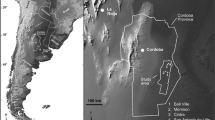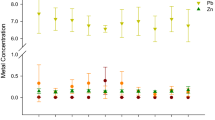Abstract
The Chaco Pampean Plain of central Argentina represents one of the largest regions with high levels of arsenic (As) in groundwater. The aim of this study was the assessment of a biotransference factor (BTF) as a tool for the estimation of As concentration in cow’s milk from As drinking water concentration. Total As content in livestock drinking water, soil, forage, and milk was determined in farms located in an area of high As groundwater, in order to analyze the relation between As uptake and its transfer to milk. The concentrations of As in milk ranged from 0.5 to 8.0 μg/L. From the results obtained, drinking water may be considered the main source of exposure to As, and the biotransference factor for milk ranges from 1.5 × 10−5 to 4.3 × 10−4. Therefore, BTF provides a simple tool for the estimation of arsenic levels in milk through the As livestock drinking water content.



Similar content being viewed by others
References
Adriano D (2001) Trace elements in terrestrial environments: biogeochemistry, bioavailability, and risks of metals. Ed. Springer –Verlag, Snd ed., New York
Alvarado J (1996) Microwave dissolution of plant tissue and the subsequent determination of trace lantanides ICP-MS. Anal Chim Acta 322:11–20
APHA (1993) Standard methods for the examination of water and wastes. American Public Health Association, Washington DC
Bates M, Smith A, Hopenhayn-Rich C (1992) Arsenic ingestion and internal cancers: a review. Am J Epidemiol 135:462–476
Bavera G, Rodriguez E, Beguet H, Bocco O, Sanchez J (2001) Water and watering places. Ed Hemisferio Sur, Buenos Aires, Argentina (in Spanish)
Beni C, Diana G, Marconi S (2008) Bovine milk chain in Italian farms. I. Arsenic levels in soil, gravitational and clean water, bovine diet, and milk. Agrochimica 52:99–115
Bhattacharya P, Welch AH, Stollenwerk KG, McLaughlin MJ, Bundschuh J, Panaullah G (2007) Arsenic in the environment: biology and chemistry. Sci Total Environ 379:109–265
Biagini R, Salvador M, Querio R, Torres Soruco C, Biagini M, Diez Barrantes A (1995) HACRE: diagnosed cases in the period 1972–1993 Argentine. Arch Dermatol 45:47–52 (in Spanish)
Cervera ML, Lopez JC, Montoro R (1994) Arsenic content of Spanish cows’ milk determined by dry ashing hydride generation atomic absorption spectrometry. J Dairy Res 61:83–89
Di Rienzo JA, Casanoves F, Balzarini MG, Gonzalez L, Tablada M, Robledo CW (2015) InfoStat versión. Grupo InfoStat, FCA, Universidad Nacional de Córdoba, Argentina. URL: http://www.infostat.com.ar
SENASA (National Health Service and Food Quality) (2009) National plan of waste control and food hygiene. (in Spanish)
Ghosh A, Majumder S, Awal MA, Rao DR (2013) Arsenic exposure to dairy cows in Bangladesh. Arch Environ Contam Toxicol 64:151–159
Hopenhayn-Rich C, Biggs M, Fuchs A, Bergoglio R, Tello E, Nicolli H, Smith A (1996) Bladder cancer mortality associated with arsenic in drinking water in Argentina. Epidemiology 7(2):117–123
Ibañez S (2007) Evaluación preliminar, en bovino y caprino, de la relación de la ingesta de arsénico y el contenido total del elemento en leche y queso. Universidad de Tarapacá, Arica, Chile, Tesis
International Dairy Federation (1986) Levels of trace elements in milk and milk products. Questionnaire 2386/E. IDF, Brussels
Kabata Pendias A, Pendias H (1992) Trace elements in soils and plants, 2nd edn. CRC Press, Boca Raton, Ann Arbor, London, pp 203–209
Kertulis GM, Ma LQ, MacDonald GE, Chen R, Winefordner JD, Cia Y (2005) Arsenic speciation and transport in Pteris vittata L. and the effects on phosphorous in the xylem sap. Environ Exp Bot 54:239–247
Kloke A, Sauerbeck D, Vetter H (1984) The contamination of plants and soils with heavy metals and the transport of metals in terrestrial food chains. In: Nriagu J (ed) Changing metal cycles and human health. Springer, Berlín, pp 113–141
Kroner SM, Cozzie DA (1999) Data collection for the hazardous waste identification rule section 10.0 farm food chain and terrestrial foodweb data. U.S. Environmental Protection Agency, Washington DC, p 46pp
Law 24.051. 1993. Regime for hazardous wastes. Argentine. National. Decree 831/93. (in Spanish)
Licata P, Trombetta D, Cristiani M, Giofre F, Martino D, Calo M, Naccari F (2004) Levels of “toxic” and “essential” metals in samples of bovine milk from various dairy farms in Calabria, Italy. Environ Int 30:1–6
Mandal K, Suzuki K (2002) Arsenic round the world: a review. Talanta 58:201–235
Navoni JA, De Pietri D, Olmos V, Gimenez C, Mitre GB, de Titto E, Lepori EV (2014) Human health risk assessment with spatial analysis: study of a population chronically exposed to arsenic through drinking water from Argentina. Sci Total Environ 499:166–174
Nicolli H, Suriano J, Gomez Peral M, Ferpozzi L, Baleani O (1989) Groundwater contamination with arsenic and other trace elements in an area of the Pampa, Province of Cordoba, Argentina. Environ Geol Water Sci 14:3–16
Pérez-Carrera A, Fernández-Cirelli A (2005) Arsenic concentration in water and bovine milk in Cordoba, Argentina. Preliminary results. J Dairy Res 72:122–124
Pou SA, Osella AR, del Pilar DM (2011) Bladder cancer mortality trends and patterns in Córdoba, Argentina (1986–2006). Cancer Causes Control 22:407–415
Rana T, Bera AK, Das S, Bhattacharya D, Pan D, Das SK (2014) Subclinical arsenicosis in cattle in arsenic endemic area of West Bengal, India. Toxicol Ind Health 30:328–335
Rosas I, Belmont R, Armienta A, Baez A (1999) Arsenic concentrations in water, soil, milk and forage in Comarca Lagunera, Mexico. Water Air Soil Pollut 112:133–149
Schoof RA, Yost LJ, Eickhoff J, Crecelius EA, Cragin DW, Meacher DM, Menzel DB (1999) A market basket survey of inorganic arsenic in food. Food Chem Toxicol 37:839–846
Sigrist M, Beldoménico H, Repetti MR (2010) Evaluation of the influence of arsenical livestock drinking waters on total arsenic levels in cow’s raw milk from Argentinean dairy farms. Food Chem 121:487–491
Smedley PL, Kinniburg D (2002) A review of the source, behaviour and distribution of arsenic in natural waters. Appl Geochem 17:517–568
Smedley PL, Nicolli HB, Barros AJ, Tullio JO (1998) Origin and mobility of arsenic in groundwater from the Pampean Plain, Argentina. In: Arehart GB, Hulston JR (Eds.), Water-Rock Interaction. Proc. 9th International Symp., Taupo, New Zealand. Balkema, Rotterdam, p 275–278
Smedley PL, Nicolli HB, Macdonald DM, Barros AJ, Tullio JO (2002) Hydrogeochemistry of arsenic and other inorganic constituents in groundwaters from La Pampa, Argentina. Appl Geochem 17:259–284
Stevens J (1991) Disposition of toxic metals in the agricultural food chain. 1. Steady-state bovine milk biotransfer factors. Environ Sci Technol 25:1289–1294
Temiz H, Soylu A (2012) Heavy metal concentrations in raw milk collected from different regions of Samsun, Turkey. Int J Dairy Technol 65:516–522
U.S. EPA (Environmental Protection Agency). (1997) Parameter guidance document. EPA, National Center for Environmental Assessment, NCEA-0238
USDA (1996) Soil survey laboratory methods manual. Soil survey investigation report N° 42. Versión 3.0. 693 pp. Washington DC, USA
Waldner DN, Looper ML (2007) Water for dairy cattle. Cooperative extension service, New Mexico State University. Guide D-107, USA, p 1–5
Warren G, Alloway B, Lepp N, Singh B, Bochereau F, Penny C (2003) Field trials to assess the uptake of arsenic by vegetables from contaminated soils and soil remediation with iron oxides. Sci Total Environ 31:19–33
WHO (World Health Organization) (2001) Environmental health criteria 224, Arsenic and arsenic compounds. Inter-organization programme for the sound management of chemicals. Geneva
Wilkins C, Salter L (2003) Arsenic hyperaccumulation in ferns: a review. Royal society of chemistry, environmental chemistry group bulletin, p 8–10
Yost LJ, Schoof RA, Aucoin R (1998) Intake of inorganic arsenic in the North American diet. Hum Ecol Risk Assess 4:137–152
Acknowledgments
Authors are indebted to the University of Buenos Aires and to CONICET (National Research Council) for financial support.
Author information
Authors and Affiliations
Corresponding author
Additional information
Responsible editor: Philippe Garrigues
Rights and permissions
About this article
Cite this article
Pérez-Carrera, A., Alvarez-Gonçalvez, C.V. & Fernández-Cirelli, A. Transference factors as a tool for the estimation of arsenic milk concentration. Environ Sci Pollut Res 23, 16329–16335 (2016). https://doi.org/10.1007/s11356-016-6731-0
Received:
Accepted:
Published:
Issue Date:
DOI: https://doi.org/10.1007/s11356-016-6731-0




